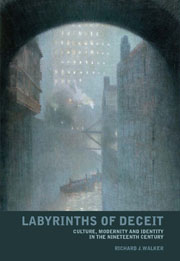Book contents
- Frontmatter
- Contents
- Acknowledgements
- Introduction: Tracing the fragments of modernity
- Part I (De)Generating doubles: duality and the split personality in the prose writing of James Hogg, Robert Louis Stevenson and Oscar Wilde
- Introduction
- 1 Speaking and answering in the character of another: James Hogg's private memoirs
- 2 He, I say – I cannot say, I: Robert Louis Stevenson's strange case
- 3 The psychopathology of everyday narcissism: Oscar Wilde's picture
- Part II The stripping of the halo: religion and identity in the poetry of Alfred Tennyson, James ‘B. V.’ Thomson and Gerard Manley Hopkins
- Part III Infected ecstasy: addiction and modernity in the work of Thomas De Quincey, Alfred Tennyson, Christina Rossetti and Bram Stoker
- Conclusion: Ghost-script
- Notes
- Bibliography
- Index
3 - The psychopathology of everyday narcissism: Oscar Wilde's picture
from Part I - (De)Generating doubles: duality and the split personality in the prose writing of James Hogg, Robert Louis Stevenson and Oscar Wilde
- Frontmatter
- Contents
- Acknowledgements
- Introduction: Tracing the fragments of modernity
- Part I (De)Generating doubles: duality and the split personality in the prose writing of James Hogg, Robert Louis Stevenson and Oscar Wilde
- Introduction
- 1 Speaking and answering in the character of another: James Hogg's private memoirs
- 2 He, I say – I cannot say, I: Robert Louis Stevenson's strange case
- 3 The psychopathology of everyday narcissism: Oscar Wilde's picture
- Part II The stripping of the halo: religion and identity in the poetry of Alfred Tennyson, James ‘B. V.’ Thomson and Gerard Manley Hopkins
- Part III Infected ecstasy: addiction and modernity in the work of Thomas De Quincey, Alfred Tennyson, Christina Rossetti and Bram Stoker
- Conclusion: Ghost-script
- Notes
- Bibliography
- Index
Summary
‘Fin de siècle,’ murmured Lord Henry.
‘Fin du globe,’ answered his hostess.
‘I wish it were fin du globe,’ said Dorian, with a sigh. ‘Life is a great disappointment.’
It is in … excess that madness lies – in the exaggerated development of natural passions of human nature not in the appearance of new passions in it.
The dandy is a creation of the English who were leaders in world trade.
In The Picture of Dorian Gray, the final seminal representation of duality in nineteenth-century fiction, Oscar Wilde, like Robert Louis Stevenson before him, offers a Gothic vision of London from the perspective of an outsider. Wilde, as an anglicized Irishman, can be regarded as a figure shaped by a radically different social, cultural and religious sensibility to that of Hogg and Stevenson, who at least share a conception of the world informed by avid and inflexible Calvinism. Nonetheless, Wilde's perspective in Dorian Gray provides instructive points of comparison with the tales of duality offered by the two Scottish writers. As indicated, an initial convergence, at least for Wilde and Stevenson, lies in their representation of London. At a significant point in the narrative, Dorian, after rejecting his actress sweetheart Sibyl Vane, is represented as wandering through the metropolis in such a way that both east and west -end are brought into a juxtaposition that evokes the sharply dualistic nature of the city.
- Type
- Chapter
- Information
- Labyrinths of DeceitCulture, Modernity and Identity in the Nineteenth Century, pp. 91 - 116Publisher: Liverpool University PressPrint publication year: 2008

